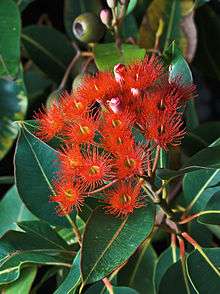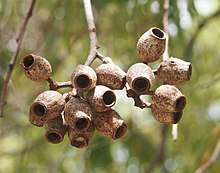Corymbia
Corymbia is a genus of about one hundred species of tree that, along with Eucalyptus, Angophora and several smaller groups, are referred to as eucalypts. Until 1990, corymbias were included in the genus Eucalyptus and there is still considerable disagreement among botanists as to whether separating them is valid. As at January 2020, Corymbia is an accepted name at the Australian Plant Census.
| Corymbia | |
|---|---|
 | |
| Corymbia ficifolia near Austins Ferry | |
| Scientific classification | |
| Kingdom: | Plantae |
| Clade: | Tracheophytes |
| Clade: | Angiosperms |
| Clade: | Eudicots |
| Clade: | Rosids |
| Order: | Myrtales |
| Family: | Myrtaceae |
| Subfamily: | Myrtoideae |
| Tribe: | Eucalypteae |
| Genus: | Corymbia K.D.Hill & L.A.S.Johnson[1] |
| Type species | |
| Corymbia gummifera | |
| Diversity | |
| about 113 species | |

Description
Eucalypts in the genus Corymbia are trees, sometimes mallee-like, that either have rough, fibrous or flaky bark, or smooth bark that is shed in small flakes or short strips. Young plants and coppice regrowth have leaves that differ from adult leaves. The adult leaves are arranged alternately (strictly disjunct opposite, but appearing alternate), with oil glands. The flower buds are arranged in groups on a branching peduncle, each branch usually with seven buds, but with the pedicels of differing lengths, so that the inflorescence is flat-topped or convex. The anthers are joined to the filament at their mid-point and open by parallel slits. As in Eucalyptus, the five sepals are fused to form an outer calyptra (or operculum) and the five petals an inner calyptra, the two calyptra being shed separately or together as the flower opens. Also as in Eucalyptus the fruit is usually a woody capsule, but in this case the disc is always depressed and the valves are always enclosed.[3][4][5][6]
Taxonomy and naming
The genus Corymbia was first formally described in 1995 by Ken Hill and Lawrie Johnson in the journal Telopea. The type species is C. gummifera.[2][3] The genus name, Corymbia is from the Latin word corymbus, meaning "a corymb".[7]
The bloodwoods had been recognised as a distinct group within the large and diverse genus Eucalyptus since 1867. Molecular research in the 1990s, however, showed that they, along with the rest of the section Corymbia, are more closely related to Angophora than to Eucalyptus, and are now regarded as a separate genus by the Australian Plant Census.[1] All three genera, Angophora, Corymbia and Eucalyptus, are closely related, and are generally referred to as "eucalypts".[8][9]
Botanists Ken Hill and Lawrie Johnson were the first to define the genus Corymbia in 1995, identifying the bloodwoods, ghost gums and spotted gums as a group distinct from Eucalyptus.[3]
Since 1995, there have been ongoing investigations into the relationships between the genera. Genetic analysis of ETS and ITS sequences of DNA in 2006 by Carlos Parra-O and colleagues of 67 taxa (47 of which were within Corymbia) yielded Corymbia and Angophora as each other's closest relatives, with the genus Eucalyptus as an earlier offshoot. The small genera Eucalyptopsis, Stockwellia and Allosyncarpia formed a clade which arose earlier still.[10] In 2009, Parra-O and colleagues added more taxa and published a combined analysis of nuclear rDNA (ETS + ITS) and morphological characters published to clarify relationships within the genus. This confirmed two main clades, which they defined as the subgenera Corymbia and Blakella.[8][11]
Species list
Distribution
Species of Corymbia occur in all mainland states of Australia and in the Northern Territory. There are about 100 species, all endemic to Australia except for four species that also occur in New Guinea, and one that is endemic to that country.[1][5]
 Corymbia, capsules (fruit)
Corymbia, capsules (fruit) Corymbia flowers
Corymbia flowers Corymbia capsules (fruit)
Corymbia capsules (fruit)
References
- "Corymbia". Australian Plant Census. Retrieved 27 January 2020.
- "Corymbia". APNI. Retrieved 25 January 2020.
- Hill, Kenneth D.; Johnson, Lawrence A.S. (13 December 1995). "Systematic studies in the eucalypts. 7. A revision of the bloodwoods, genus Corymbia (Myrtaceae)". Telopea. 6 (2–3): 185–504. doi:10.7751/telopea19953017.
- "Corymbia". FloraBase. Western Australian Government Department of Parks and Wildlife.
- Hill, Ken. "Corymbia". Royal Botanic Garden Sydney. Retrieved 28 January 2020.
- Messina, Andre; Stajsic, Val. "Corymbia". Royal Botanic Gardens Victoria. Retrieved 28 January 2020.
- Francis Aubie Sharr (2019). Western Australian Plant Names and their Meanings. Kardinya, Western Australia: Four Gables Press. p. 71. ISBN 9780958034180.
- Barrow, Jim. "Corymbia, Corymbia ... wherefore art thou Corymbia?". Association of Societies for Growing Australian Plants. Retrieved 28 January 2020.
- "A brief history of Eucalyptus, Angophora and Corymbia". Euclid: Centre for Australian National Biodiversity Research. Retrieved 28 January 2020.
- Parra-O., Carlos; Bayly, Michael; Udovicic, Frank; Ladiges, Pauline (2006). "ETS sequences support the monophyly of the eucalypt genus Corymbia (Myrtaceae)". Taxon. 55 (3): 653–63. JSTOR 25065641.
- Parra-O., C.; Bayly, M. J.; Drinnan, A.; Udovicic, F.; Ladiges, P. (2009). "Phylogeny, major clades and infrageneric classification of Corymbia(Myrtaceae), based on nuclear ribosomal DNA and morphology". Australian Systematic Botany. 22 (5): 384–399. doi:10.1071/SB09028.
External links
| Wikimedia Commons has media related to Corymbia. |
- Lucid Online Player - EUCLID Eucalypts of Australia (Multi-access key to 917 species/subspecies taxonomy as of December 2009, Includes Corymbias and Angophoras.)
- A New Name for the Bloodwood and Ghost Gum Eucalypts
- Currency Creek Arboretum Eucalypt Research at Currency Creek Arboretum